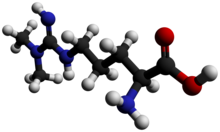
| |

| |
| Names | |
|---|---|
| IUPAC name
2-Amino-5-[[amino(dimethylamino)methylidene]amino]pentanoic acid
| |
| Other names
N(G),N(G′)-Dimethylarginine
| |
| Identifiers | |
3D model (JSmol)
|
|
| 3DMet | |
| 2261521 S | |
| ChEBI | |
| ChEMBL | |
| ChemSpider | |
| DrugBank | |
| KEGG | |
| MeSH | N,N-dimethylarginine |
PubChem CID
|
|
| UNII | |
CompTox Dashboard (EPA)
|
|
| |
| |
| Properties | |
| C8H18N4O2 | |
| Molar mass | 202.258 g·mol−1 |
| log P | −0.716 |
| Acidity (pKa) | 2.497 |
| Basicity (pKb) | 11.500 |
| Related compounds | |
Related alkanoic acids
|
|
Related compounds
|
|
Except where otherwise noted, data are given for materials in their standard state (at 25 °C [77 °F], 100 kPa).
| |
Asymmetric dimethylarginine (ADMA) is a naturally occurring chemical found in blood plasma. It is a metabolic by-product of continual protein modification processes in the cytoplasm of all human cells. It is closely related to L-arginine, a conditionally essential amino acid. ADMA interferes with L-arginine in the production of nitric oxide (NO), a key chemical involved in normal endothelial function and, by extension, cardiovascular health.